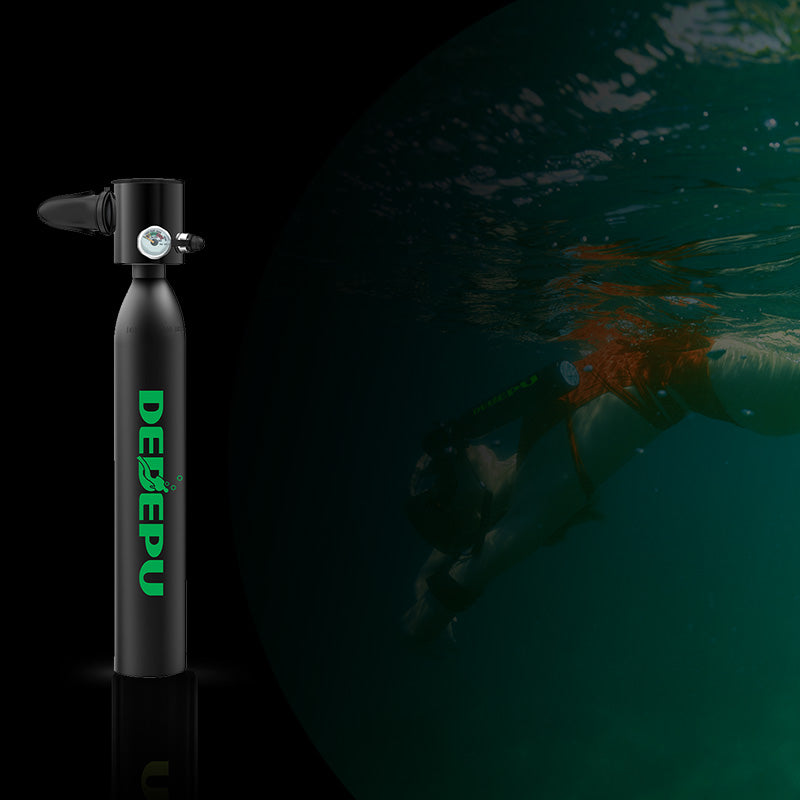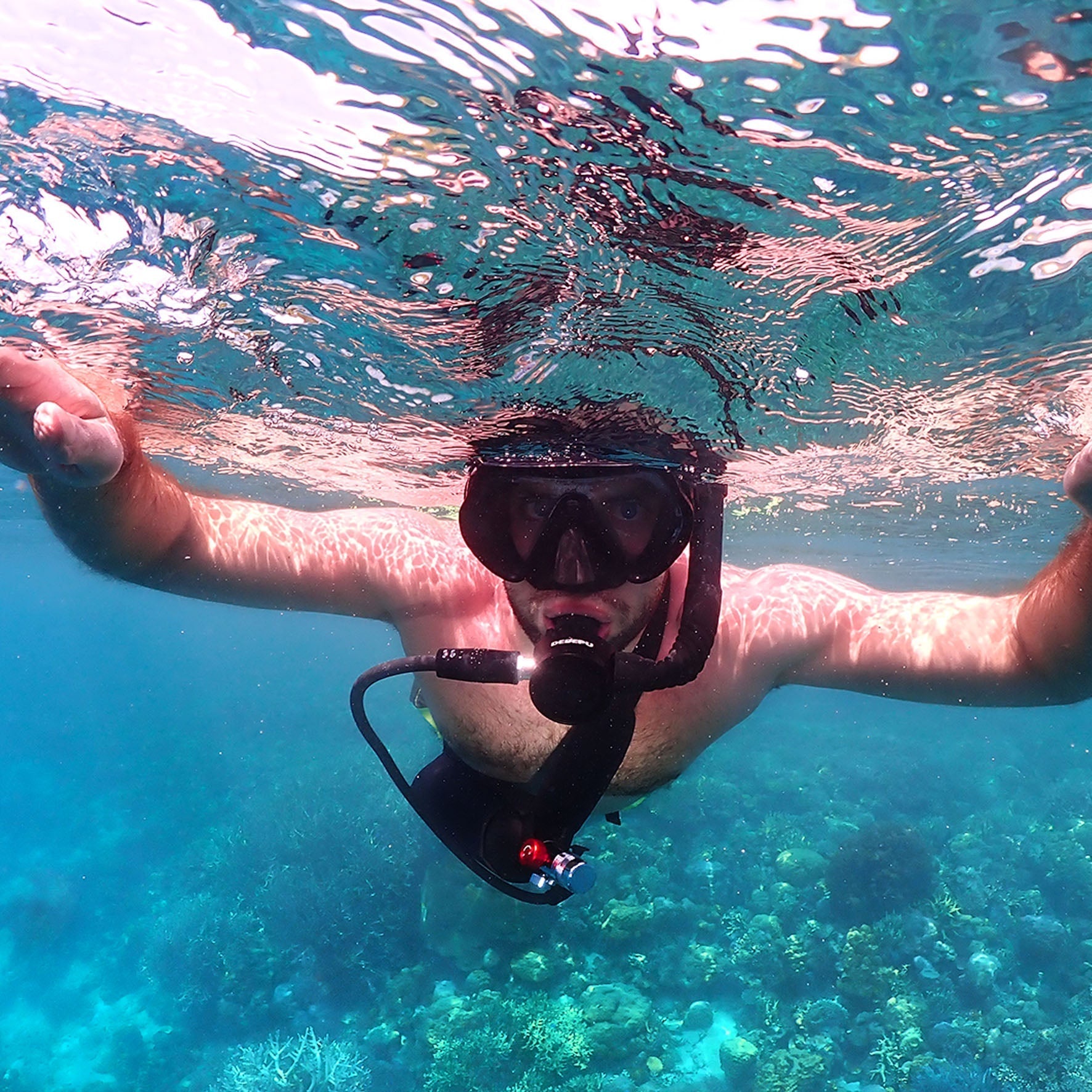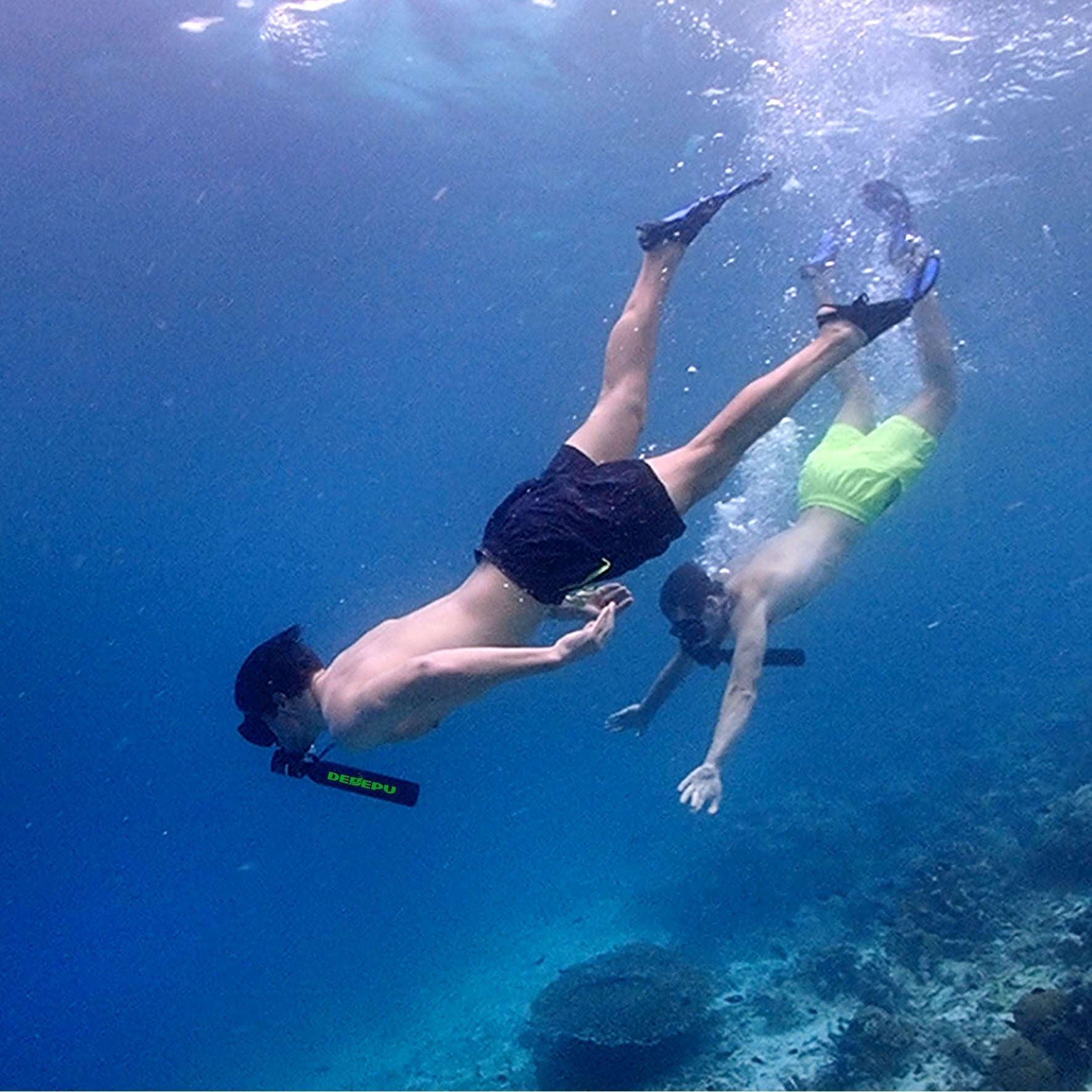Proper gear maintenance isn't optional—it's what separates 2,000 equipment that lasts 10+ years from gear that fails after 50 dives. Studies show 68% of regulator failures and 55% of BCD malfunctions trace back to poor post-dive care. A simple 10-minute freshwater rinse can prevent 80% of saltwater corrosion, while storing wetsuits properly maintains 95% of their insulation over 5 years. Divers who service regulators every 100 dives or 2 years experience 70% fewer breathing issues, and those who air-dry BCDs completely reduce mold growth by 90%. With professional servicing costing 120-200/year but emergency repairs averaging $500+, smart maintenance pays for itself in 18-24 months.
Choosing the Right Scuba Gear for Beginners
Studies show that 62% of new divers struggle with ill-fitting masks, leading to leaks and frustration. A well-sealed mask should suction to your face without straps, staying put for at least 10 seconds. Fins, meanwhile, should be snug but not cut circulation—a 5mm gap at the heel is ideal for avoiding blisters.
When it comes to regulators, entry-level models (200-400) last 5-7 years with proper care, while premium ones ($600+) can exceed 10 years and 1,000 dives. Buoyancy compensators (BCDs) should hold at least 30 lbs of lift for recreational diving, with adjustable straps within a 2-inch range to fit different body types.
Investing in the right gear early avoids $150+ in rental fees over 10 dives—and more importantly, prevents 80% of common beginner issues like poor buoyancy or air waste. Let’s break down how to choose wisely.
1. Mask: Fit Matters More Than Price
Test before buying: Press the mask to your face (no strap) and inhale lightly. A good seal holds for 8-12 seconds.
Field of view: Single-lens masks offer 180° visibility, while dual-lens designs improve peripheral vision by 15%.
Skirt material: Silicone skirts (2-5mm thick) last 3x longer than cheaper PVC alternatives.
2. Fins: Stiffness & Size Balance
Recreational fins (flex rating 30-50) work best for beginners—stiff fins (70+) waste energy.
Blade length: 22-25 inches optimizes thrust without overworking legs.
Foot pocket fit: 1/4-inch space at toes prevents cramps; neoprene socks add 2mm insulation.
3. Regulator: Reliability Over Features
Breathing resistance: Entry-level regs add 1.2-1.5 psi effort per breath; high-end models drop below 0.8 psi.
Freeze resistance: Cold-water divers need environmentally sealed models (works below 50°F/10°C).
Service intervals: Every 2 years or 100 dives—neglect increases failure risk by 40%.
4. BCD: Lift Capacity & Adjustability
Weight ranges: A 25-35 lb lift capacity suits most warm-water divers; cold water demands +10 lbs.
Harness fit: Should allow 2 fingers of slack under straps to avoid chafing.
Integrated weights: Systems with 5-10 lb pockets reduce belt slippage (a top 3 complaint).
5. Wetsuit: Thickness = Warmth + Mobility
Tropical diving (75°F+) → 3mm suits retain core heat for 60-90 min dives.
Temperate water (60-75°F) → 5mm suits with hoods extend dive time by 30%.
Seam construction: Flatlock stitching leaks 50% less water than overlock seams.
Tip: Budget Smart
800-1,200 covers a full beginner kit (mask, fins, reg, BCD, computer).
Renting costs 50-80 per dive trip—owning pays off after 15-20 dives.
Annual maintenance: 120-200 keeps gear safe and extends lifespan 2-3x.
Bottom line: Measure twice, buy once. Test gear in a pool before open water—85% of fit issues surface in the first 30 minutes.

Understanding Your Dive Equipment
Divers who understand their equipment reduce air consumption by 15-20% and avoid 72% of preventable malfunctions. A standard aluminum 80-cubic-foot tank holds 77 cubic feet of air at 3,000 psi, enough for 45-60 minutes at 30 feet—but poor buoyancy control can slash that time to 30 minutes.
Your regulator delivers air at 1.4-1.7 psi per breath; if it spikes above 2 psi, it’s time for servicing. BCDs inflate at 0.5-1.0 liters per second—too slow risks slow ascents, too fast wastes air. Dive computers track ascent rates (30 ft/min max) and no-deco limits with ±1% accuracy; ignoring alarms increases decompression sickness risk by 40%.
1. Tank: Air Supply Math
Aluminum 80cf: Weighs 31 lbs empty, 45 lbs full; lasts 1 hour at 20 ft but just 25 min at 60 ft.
Steel 100cf: Holds 20% more air but adds 7 lbs—better for cold water (retains heat 15% longer).
Pressure checks: Tanks lose 50-100 psi/year from permeation; hydrotesting every 5 years is mandatory.
2. Regulator: Breathing Efficiency
First stage: Reduces tank pressure from 3,000 psi to 140 psi (intermediate pressure).
Second stage: Drops to 1.5 psi above ambient; high-end models cut effort to 0.8 psi.
Freeflow risk: Occurs in 1 in 200 dives—caused by sand, freezing, or >2 psi imbalance.
3. BCD: Buoyancy Control
Lift capacity: 25-35 lbs for recreational diving; cold water needs +10 lbs for thicker suits.
Inflation speed: 0.8 L/sec is ideal; slower than 0.5 L/sec delays emergency ascents.
Dump valves: Should release air at 5-10 L/sec—stuck valves cause 12% of buoyancy failures.
4. Dive Computer: Algorithm Safety
RGBM vs. ZHL-16: Conservative models add 15% more no-deco time than liberal ones.
Battery life: 200-300 dives for coin cells; rechargeables last 500+ dives but cost 3x more.
Refresh rate: Updates depth/speed every 0.5 seconds; laggy screens increase error rates 5-fold.
5. Gauges: Precision Matters
SPG accuracy: ±5% is standard; 10% deviation means replace immediately.
Depth sensors: Off by >1.5 ft? Calibrate or risk violating no-deco limits.
Console size: 2-inch dials are readable at 3 ft distance in low viz.
Checks Before Diving
Regulator test: Breathe 5 times while watching SPG—pressure drop >50 psi signals leaks.
BCD test: Inflate fully; if it deflates >10% in 2 minutes, check valves.
Computer sync: Confirm it matches your tank’s pressure within 5%.
Bottom line: Gear knowledge cuts air waste, extends bottom time, and prevents 90% of “oh shit” moments. Test everything on land—85% of failures show symptoms before the dive.
Learning to Breathe Underwater
Breathing through a regulator isn’t natural—your body burns 12-15% more oxygen underwater due to stress and unfamiliar resistance. A new diver’s air consumption averages 25-30 liters per minute (L/min), while experienced divers drop to 15-18 L/min. That difference means 50% longer dive times just by breathing right.
Most beginners take 22-26 breaths per minute—way above the ideal 12-16 bpm. Panic spikes this to 40+ bpm, draining a tank in 20 minutes flat. Proper technique cuts air use by 20%, turning a 30-minute dive into 36 minutes without changing gear.
The physics of breathing underwater changes everything. At just 33 ft (10 m), the pressure compresses air to twice its surface density—meaning each breath delivers twice the oxygen molecules, but your lungs don’t feel the difference. This is why divers who panic at depth burn through air 3x faster; their bodies aren’t used to processing so much oxygen per breath. A regulator adds resistance too—cheap models force you to work harder, adding 1.5-2.0 psi per inhale, while high-end ones keep it below 1.0 psi.
Key breathing mistakes that waste air:
Holding your breath (increases CO₂ retention by 40%)
Shallow breathing (reduces oxygen absorption by 15-20%)
Overbreathing (spikes air consumption to 30+ L/min)
The best way to improve is by training your diaphragm. Slow, controlled breaths—4 seconds in, 6 seconds out—optimize gas exchange and keep your heart rate low. Adding a 1-2 second pause after each inhale boosts oxygen uptake by 8-10%. Divers who master this rhythm can hover at 60 ft for 50+ minutes on a single tank, while beginners might struggle to hit 30 minutes.
Gear plays a role too. A poorly fitted mouthpiece causes jaw fatigue in 70% of divers within 20 minutes, forcing them to surface early. Exhaust valves should release bubbles at a 45° angle—if they’re misaligned, you’ll waste 15% more energy on each exhale. Even hose length matters: anything longer than 32 inches adds drag, increasing breathing effort by 1.5 psi per extra foot.
Stress is the silent air killer. When your heart rate crosses 100 bpm, your air consumption jumps 30%—even if you’re not moving. That’s why good divers practice recovery breathing after swimming against current: 3-5 slow, deep breaths can normalize your intake faster than gasping for air. Task loading (like managing buoyancy while clearing a mask) spikes consumption 40-50%, which is why instructors drill skills until they’re automatic.
Tracking progress is crucial. Your Surface Air Consumption (SAC) rate should drop below 0.5 cu ft/min with practice—a diver who starts at 0.8 and improves to 0.4 effectively gains 10+ minutes per dive. At 8-12 per tank fill, that’s 200+ saved annually for weekly divers.
Bottom line: The difference between a 30-minute dive and a 60-minute dive isn’t gear—it’s how you breathe. Master the rhythm, and you’ll outlast divers with fancier setups.
Staying Safe While Diving
Diving accidents are rare, but 92% are preventable with proper protocols. A typical scuba fatality involves 3-4 small mistakes compounding, like skipping a buddy check (38% of incidents), ignoring ascent rates (25% of cases), or misreading air gauges (18% of emergencies).
New divers average 1 safety violation per 5 dives, while experienced divers commit 1 per 20 dives. The difference? Checklists. Divers who religiously follow pre-dive checks reduce their risk of equipment failure by 73%.
1. The 5-Point Buddy Check (BWRAF)
BCD: Inflate/deflate test—should hold air for 2+ minutes without leaks.
Weights: Confirm 5-10% of body weight is secured (e.g., 8 lbs for a 160-lb diver).
Releases: Practice locating all 3-5 quick releases in under 10 seconds.
Air: Test both primary and alternate regulators for 1.0-1.5 psi breathing effort.
Final OK: Verify computer is set to 21% O₂ unless nitrox diving.
2. Ascent Rules You Can’t Ignore
30 ft/min max ascent rate—faster risks lung overexpansion (1.5x pressure increase per 33 ft).
Safety stop: 3 minutes at 15 ft reduces microbubble formation by 50%.
Surface interval: Wait at least 1 hour before flying to keep DCS risk below 1%.
3. Air Management That Actually Works
Turn back at 50%: If your tank hits 1,500 psi at 60 ft, start ascending.
Reserve 500 psi: Enough for 5-minute safety stop + emergency (uses 300 psi).
Gauge checks: Every 5 minutes—ignoring them causes 42% of out-of-air emergencies.
4. Handling Common Problems
Regulator freeflow: Occurs in 1 in 200 dives—breathe normally until it stops or switch to alternate.
Mask flood: Clear in <3 seconds—delays cause 60% of panic episodes.
Entanglement: Carry shears; cutting takes 8-12 seconds vs. 2+ minutes struggling.
5. Post-Dive Safety
Hydration: Drink 16 oz water per dive—dehydration raises DCS risk 30%.
Symptom watch: Monitor for joint pain (45% of DCS cases) or fatigue (25%) for 24 hours.
Gear rinse: Salt corrosion damages 15% of equipment annually—freshwater soak for 30+ minutes.
Bottom line: Safety isn’t luck—it’s 500 small habits. Master checks, respect limits, and always plan dives so boring that nothing surprising happens.
Maintaining Your Gear After the Dive
Saltwater and neglect destroy dive gear 3x faster than regular use. A regulator left unrinsed loses 50% of its lifespan—instead of lasting 1,000 dives, it might fail at 500. BCDs soaked in saltwater without rinsing develop 80% more mold in just 48 hours, and wetsuits lose 30% of their insulation after 20 dives without proper drying.
Divers who skip maintenance pay $200+ extra per year in repairs—but those who follow a 10-minute post-dive routine cut long-term costs by 60%. Here’s how to keep your gear working like new.
1. Rinsing: The 90% Solution
Regulators: Soak first stage in freshwater for 30 minutes—salt crystals jam internal parts at 140 psi, causing 40% of service failures.
BCD’s: Inflate halfway, then flush the bladder with 1 gallon of freshwater—this prevents 70% of valve corrosion.
Wetsuits: Turn inside out and rinse for 5 minutes—salt residue reduces neoprene flexibility by 15% per season.
2. Drying: Stop Mold Before It Starts
Hang BCDs upside down—trapped moisture causes 90% of bladder leaks.
Wetsuits dry at room temp—direct sunlight damages neoprene 2x faster.
Store masks with straps loose—stretched straps lose 20% elasticity per year.
3. Storage: Small Habits, Big Savings
Keep regs pressurized at 200-300 psi—this prevents O-ring deformation (#1 cause of leaks).
Avoid coiled hoses—bends sharper than 3-inch radius crack internally within 6 months.
Silica gel packs in gear bags cut humidity damage by 50%.
4. Service Intervals You Can’t Skip
Regulators: Every 2 years or 100 dives—delaying adds $150 to repair costs.
BCD inflators: Lubricate every 50 dives—grit buildup causes 30% of failure-to-inflate cases.
Computers: Battery replacement every 200 dives—a dead computer mid-dive risks $500+ deco penalties.
5. Cost-Saving Pro Tips
DIY rinsing kits (25) save 5 per dive vs. shop rinses.
Annual professional servicing (120) prevents 400 emergency repairs.
Replace mouthpieces yearly—a 10 part avoids 80 regulator overhauls.
Bottom line: Gear lasts 10 years with care or 3 years without. Spend 15 minutes post-dive, and you’ll never miss a dive due to equipment failure.






Leave a comment
All comments are moderated before being published.
This site is protected by hCaptcha and the hCaptcha Privacy Policy and Terms of Service apply.